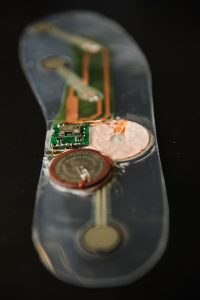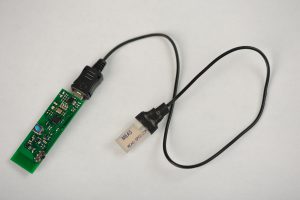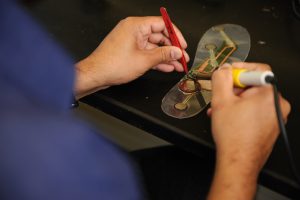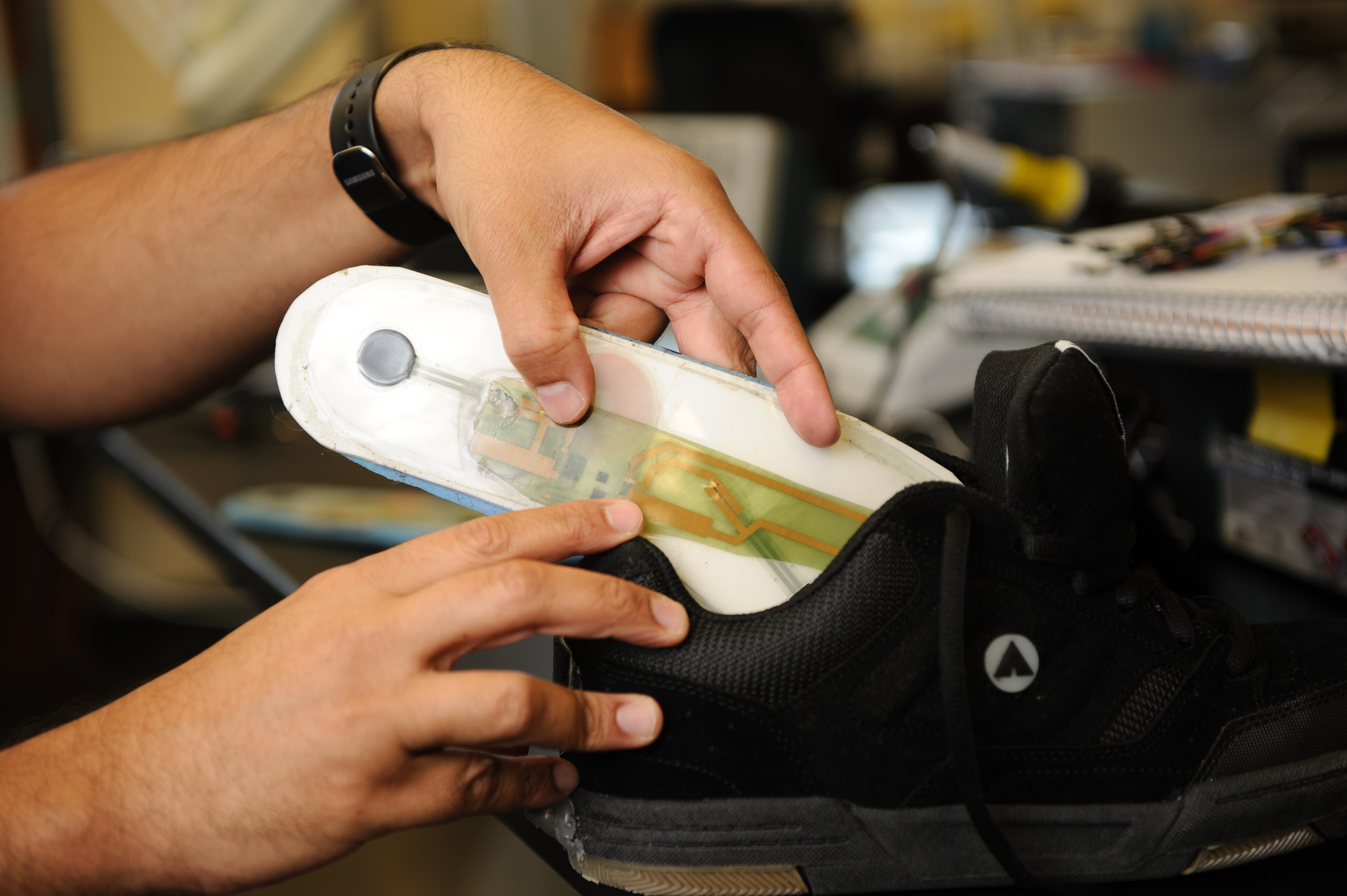By Adam Jones
Photos by Matthew Wood

There was a time when our bodies only met computers at doctors’ offices. There, heavy, bulky equipment was wheeled in and attached to our body to measure something inside.
Now, designer bracelets track our movements and heart rates and connect to powerful pocket computers that double as phones.
Wedding technology to our body is no longer science fiction. It’s fashionable.
Now, we want increased accuracy that brings more data. That’s coming, to be sure, but besides finding better ways to monitor our bodies, we need a way to make sense of the data.
In his engineering lab at The University of Alabama, Dr. Edward Sazonov works on improving ways to monitor the body and to use the resulting data to improve behaviors.
“One task is to objectively measure something, but, once you have the data, what do you do with that?” asks Sazonov.
“Right now, a very popular direction of research is trying to use sensors to model human behavior and then trying to use this model to close the loop – that is modifying the behavior to move toward a goal. We’re trying to close the loop.”
Interestingly, Sazonov’s doctoral dissertation was on monitoring bridges for structural health using signal processing and pattern recognition. The technology of using electronic sensors and computers to find structural faults on a bridge is similar to the techniques used on the human body, Sazonov says.

Research is driven by need. Sazonov’s work on wearable sensors attempts to address areas where medical researchers, medical practitioners and even casual consumers need data on the body.
“Some people are very motivated to do self-monitoring, and they want to be aware of every aspect of their body, which is not as easy as you would think because many of our behaviors are automatic, so you aren’t even aware you are doing something,” he says. “Looking at objective data allows people to know more about themselves.”
One of the bigger needs in healthcare is accurate data on how much we eat or how much energy we consume. More than two-thirds of adults in the United States are clinically overweight or obese, according to estimates from the Center for Disease Control and Prevention, and obesity leads to other health problems.
Having accurate diet data could improve behavioral weight loss strategies or trigger new weight-loss interventions. The data could help assess the effectiveness of pharmacological and behavioral interventions for eating disorders. If readily-available technology could track eating, health-conscious people could keep a record of their diet without keeping a diary.
Self-reporting of diets is nearly worthless. Studies find even nutritionists underestimate what and how much they eat, and accurate methods of measuring energy intake and output are expensive, laborious and require medical specialization.
Sazonov designed a device he calls the Automatic Ingestion Monitor, or AIM. It has potential to monitor eating by automatically detecting and capturing imagery of food intake and to estimate the mass and the energy content of ingested food.

About the size of a Bluetooth headset, the AIM includes a camera and sensor worn around the ear to automatically track diet. The sensor feels vibrations from movement in the jaw during food intake, and the device is programmed to filter out jaw motions, such as talking, that are not coming from drinking or eating.
Estimates of energy intake would be taken from the pictures of food or drink. In addition, AIM can describe in much greater detail what happens during a meal: how quickly the food was eaten, the meal’s duration and so on.
The device could potentially provide real-time feedback, changing or stopping what someone is eating, he says.
A human trial has validated the AIM’s functionality. Sazonov hopes to produce a device not just for use in research and clinical settings, but also for everyday use. It’s likely the consumer-friendly AIM would cost about as much as current activity trackers.
“We are actively working on polishing and improving the device to become available to the consumers,” he says. “This includes more than just designing better electronics and phone apps, but also developing meaningful feedback to the user that could let one modify their eating habits.”
While the AIM tracks energy intake, Sazonov is also developing a sensor to track energy output, or, more simply, activity. While available fitness monitors measure motion and heart pulse to gauge activity, Sazonov is developing a shoe insole that could be more accurate.
Sazonov’s smart shoe research began as a way to study risk of falling and gait in the rehabilitation of stroke patients but has morphed into an activity tracker.
Using pressure sensors embedded into a shoe insole, the device could tell not only motion but the types of motion. The sensors can detect specific activities and whether, for examples, the person is standing, sitting or lying. That’s important as our bodies expend different amounts of energy for different activities. Using the legs to walk, for example, takes less energy than moving the legs to ride a bike or run.
“It is very accurate in recognition of human activity, so, once you have that, you can get an accurate measure of energy expenditure,” he says.

Sazonov and partners developed a station that charges the shoe insole wirelessly. Just place the shoe on the pad each night, and, in the morning, the shoe is ready to work. Sazonov wears one most days to help with testing.
Accuracy comparisons between the technology and commercial fitness trackers showed the shoe insole the winner, he says. Just like a bracelet, the shoe insole would work with smartphone applications to provide feedback to the user.
“If you wear a fitness monitor, you’re using the data somehow,” he said. “You’re receiving feedback from the monitor that tells you something about your behavior. That’s the value of this data.”
Besides energy use, sensors can be used on other body parts. Sazonov is working with colleagues to develop a way to track smoking by monitoring breathing and hand movement. As with the AIM and smart shoe, the Personal Automatic Cigarette Tracker, or PACT, makes tracking automatic and more accurate.

The PACT is a chest belt worn by a person that measures the volume of air breathed in and out. Combined with hand gestures, it gives a good indication of not just when a person smokes, but how deeply and how long the person holds in the smoke. The PACT is hard to trick since smoking creates a unique breathing pattern.
The tracking can reveal how much smoke they are inhaling. It could help researchers understand addiction.
“Everybody has very individual patterns of smoking,” Sazonov said. “Half a pack does not mean the same thing for everyone.”
The technology is mostly envisioned for medical research such as the development of cessation programs or therapies. The PACT could be used in human trials since it can provide an objective measurement. It could also help in clinical situations for individuals.
Sazonov and partners have done initial PACT testing and will be conducting human testing later this year.
Dr. Sazonov, an associate professor of electrical and computer engineering in UA’s College of Engineering, is the lead researcher on a $1.8 million, five-year grant from the National Institutes of Health to test the wearable sensor to track diet.
